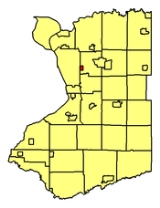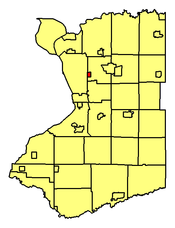
Sloan, New York
Encyclopedia

Village
A village is a clustered human settlement or community, larger than a hamlet with the population ranging from a few hundred to a few thousand , Though often located in rural areas, the term urban village is also applied to certain urban neighbourhoods, such as the West Village in Manhattan, New...
in Erie County
Erie County, New York
Erie County is a county located in the U.S. state of New York. As of the 2010 census, the population was 919,040. The county seat is Buffalo. The county's name comes from Lake Erie, which in turn comes from the Erie tribe of American Indians who lived south and east of the lake before 1654.Erie...
, New York
New York
New York is a state in the Northeastern region of the United States. It is the nation's third most populous state. New York is bordered by New Jersey and Pennsylvania to the south, and by Connecticut, Massachusetts and Vermont to the east...
, United States
United States
The United States of America is a federal constitutional republic comprising fifty states and a federal district...
. The population was 3,775 at the 2000 census. It is part of the Buffalo
Buffalo, New York
Buffalo is the second most populous city in the state of New York, after New York City. Located in Western New York on the eastern shores of Lake Erie and at the head of the Niagara River across from Fort Erie, Ontario, Buffalo is the seat of Erie County and the principal city of the...
–Niagara Falls
Niagara Falls, New York
Niagara Falls is a city in Niagara County, New York, United States. As of the 2010 census, the city had a total population of 50,193, down from the 55,593 recorded in the 2000 census. It is across the Niagara River from Niagara Falls, Ontario , both named after the famed Niagara Falls which they...
Metropolitan Statistical Area
Buffalo-Niagara Falls metropolitan area
The Buffalo-Niagara Falls Metropolitan Statistical Area is a metropolitan area, designated by the United States Census Bureau, encompassing two counties – Erie and Niagara – in Western New York, with a population, as of the 2010 census, of 1,135,509 inhabitants...
.
The Village of Sloan is within the Town of Cheektowaga and borders on the City of Buffalo
Buffalo, New York
Buffalo is the second most populous city in the state of New York, after New York City. Located in Western New York on the eastern shores of Lake Erie and at the head of the Niagara River across from Fort Erie, Ontario, Buffalo is the seat of Erie County and the principal city of the...
.
History
The village was incorporated in 1896 from part of Cheektowaga. The Conrail rail yards to the village's north and south mark its historical importance as a railroad town like nearby Village of DepewDepew, New York
Depew is a village in Erie County, New York, United States. The population was 16,629 at the 2000 census. It is part of the Buffalo–Niagara Falls Metropolitan Statistical Area...
.
Geography
Sam Sloan owned the land which extended to the NYS thruway back when it was founded but it is only 1 square miles (2.6 km²) today. Sloan is located at 42°53′40"N 78°47′29"W (42.894458, -78.791353).According to the United States Census Bureau
United States Census Bureau
The United States Census Bureau is the government agency that is responsible for the United States Census. It also gathers other national demographic and economic data...
, the village has a total area of 0.8 square miles (2.1 km²), all of it land.
The village is bounded on the north by New York State Route 130
New York State Route 130
New York State Route 130 is a state highway entirely within Erie County, New York, United States. It runs east–west from U.S. Route 62 in Buffalo to the village of Depew, where it terminates at NY 78...
(Broadway) and on the east by New York State Route 240
New York State Route 240
New York State Route 240 is a state highway in western New York in the United States. The southern terminus of the route is at an intersection with NY 242 in the Ellicottville community of Ashford in northern Cattaraugus County. Its northern terminus is at a junction with NY 324...
(Harlem Road).
Demographics
As of the censusCensus
A census is the procedure of systematically acquiring and recording information about the members of a given population. It is a regularly occurring and official count of a particular population. The term is used mostly in connection with national population and housing censuses; other common...
of 2000, there were 3,775 people, 1,680 households, and 1,033 families residing in the village. The population density
Population density
Population density is a measurement of population per unit area or unit volume. It is frequently applied to living organisms, and particularly to humans...
was 4,755.6 people per square mile (1,845.0/km²). There were 1,789 housing units at an average density of 2,253.7 per square mile (874.4/km²). The racial makeup of the village was 99.05% White, 0.21% African American, 0.13% Native American, 0.13% Asian, 0.16% from other races
Race (United States Census)
Race and ethnicity in the United States Census, as defined by the Federal Office of Management and Budget and the United States Census Bureau, are self-identification data items in which residents choose the race or races with which they most closely identify, and indicate whether or not they are...
, and 0.32% from two or more races. Hispanic or Latino of any race were 0.72% of the population.
There were 1,680 households out of which 24.0% had children under the age of 18 living with them, 44.5% were married couples
Marriage
Marriage is a social union or legal contract between people that creates kinship. It is an institution in which interpersonal relationships, usually intimate and sexual, are acknowledged in a variety of ways, depending on the culture or subculture in which it is found...
living together, 12.5% had a female householder with no husband present, and 38.5% were non-families. 33.3% of all households were made up of individuals and 18.9% had someone living alone who was 65 years of age or older. The average household size was 2.25 and the average family size was 2.89.
In the village the population was spread out with 20.1% under the age of 18, 6.5% from 18 to 24, 28.8% from 25 to 44, 20.4% from 45 to 64, and 24.2% who were 65 years of age or older. The median age was 42 years. For every 100 females there were 89.3 males. For every 100 females age 18 and over, there were 86.2 males.
The median income for a household in the village was $29,420, and the median income for a family was $39,863. Males had a median income of $31,679 versus $23,438 for females. The per capita income
Per capita income
Per capita income or income per person is a measure of mean income within an economic aggregate, such as a country or city. It is calculated by taking a measure of all sources of income in the aggregate and dividing it by the total population...
for the village was $15,964. About 10.1% of families and 11.5% of the population were below the poverty line, including 19.1% of those under age 18 and 3.9% of those age 65 or over.

